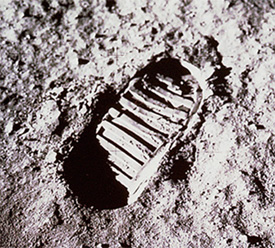
Submitted by Darrell Tesdall
In 1963, while working for Douglas Aircraft I was assigned to the design team for the third stage of the Saturn 5 rocket that later put a man on the moon. One of the first design problems that we tackled was how to chill down the rocket engine and its associated fuel lines to prevent gas bubbles from forming during ignition. If this happened the main engine pump would cavitate and keep the engine from starting. Fuel for this stage was liquid oxygen and hydrogen. To accomplish this chilldown, two pumps were used to circulate the cryogenic fuels through the engine prior to ignition. One horsepower motors were use to drive the pumps. The motor used to drive the hydrogen pump was placed inside the hydrogen tank in direct contact with the liquid hydrogen (Something that had never been done before). The motor for the liquid oxygen pump was placed in a sealed container within the LOX (Liquid Oxygen) tank.
It is obvious from the environments the motors experienced that a brush type DC motor was not a viable candidate. A three phase induction motor was the only possible option but the only power on the stage that could be used was 56 volts DC. My task was to take the 56 volts DC and change it into 400 cycle three phase AC in order to drive the motors, no small task in 1963. A 1.5 KVA inverter was designed with a modified square wave output to drive a three phase wye connected induction motor. To meet the weight (The flight unit weighted 12 pounds) and efficiency criteria, 50 amp. germanium transistors were used.
The design task was formidable. Special testing had to be applied to the 50 amp germanium transistors in order to screen out the ones that could survive the harsh environment. Only about 50% of the units tested survived. After the units were placed an inverter, the entire assembly was tested with a simulated motor load at both high and low temperatures. Strangely enough it was low temperature that gave the most problems. The gains of the germanium transistors increased at low temperatures causing them to fail by exceed their maximum current rating during motor startup. This resulted in a redesign, late in the program, where current limiting was added. Three of us worked in shifts, seven days a week, 24 hours a day, for three months to accomplish this redesign.
The operational testing of the pumps also had problems. The first time the pumps were used to chill the engine down the cryogenic fuels hitting the relatively hot engine caused so much back pressure that the pumps were turned into turbines and driven backwards at 11,000 RPM causing the inverters to fail. Adding check valves in the lines between the pumps and the rocket engine solved that problem.
The five years that I spent on the Saturn 5 program were some of the most challenging of my life. I used to have nightmares before Saturn 5 launches because I knew that if the inverters did not work properly the missions could not succeed. The third stage engine had to fire twice during a lunar mission. Once during liftoff and then again to move the Apollo capsule and its service module from earth orbit into a trajectory to the moon. Fortunately however the inverters worked flawlessly during all the Saturn 5 flights. Looking back I am still amazed at the success of the Saturn 5 rocket. It is still the most complicated piece of machinery ever built and it was designed by a bunch of us young kids who didn’t know that it couldn’t be done.
Back to Human Space Travel Primary Sources
